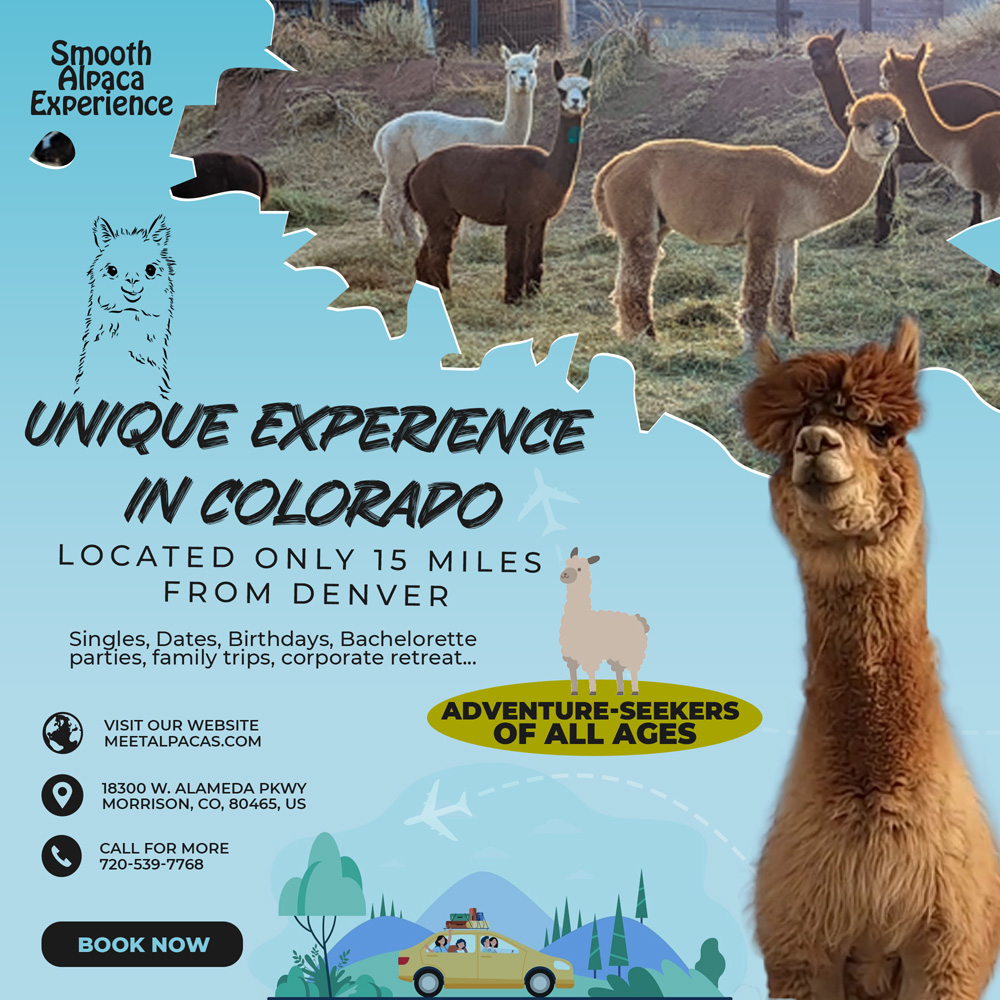Colorado alpaca adventure tours right now: Alpaca farms offer more than just a chance to get closer to nature; they also promote sustainable farming practices. Alpacas have less impact on the environment than other livestock, largely due to their soft feet that prevent soil compaction and erosion. Their grazing patterns also help to promote biodiversity in pastures, and their manure (nicknamed “alpaca gold”) is a great natural fertilizer. Additionally, alpacas have a longer lifespan and a high reproductive rate, making them a more stable source of revenue for farmers. Read extra information at alpaca experiences in Denver, Colorado.

Alpacas communicate through various sounds and body language, including gentle humming, grunting, and other nuanced vocalizations. They can also “spit” or reject male advances to let a female know she is unreceptive to his advances. The alpaca’s padded feet minimize soil compaction, allowing for sustainable, eco-friendly agricultural practices. Additionally, their manure is a natural fertilizer that enhances soil quality. This symbiotic relationship between land and herd promotes sustainable practices and healthy, nutritious foods.
Here’s why an alpaca experience is perfect for your upcoming trip to Denver. Alpacas are adorable, fluffy, and friendly animals. People are often surprised by just how sociable they are and how much they enjoy human affection. They are also incredibly calm creatures with steady temperaments. This makes them perfect for the whole family. They don’t display erratic behavior, making them more predictable around children.
As herbivores, alpacas only eat vegetation. They eat mostly grass, but their diets can also include leaves wood, bark or stems. Like other ruminants, alpacas have a three-chambered stomach that digests the roughage efficiently. Unlike other grazers, alpacas don’t eat much. According to the Alpaca Owners Association, a 125-lb. (57 kg) animal only eats around 2 lbs. (907 grams) per day. In general, alpacas eat 1.5 percent of their body weight each day.
All members of your group will have the opportunity to participate in a fully interactive experience. It typically lasts around 1 hour and 30 minutes. Its environment is ideal for nature lovers : Most people who live in Colorado love the outdoors because the state offers a little bit of everything. Even if you’re just visiting for the weekend, you can embrace all that nature has to offer. An alpaca ranch offers stunning scenery and a relaxing atmosphere where you can take in the fresh air. When you go behind the scenes on the ranch, you learn about much more than just the animals. You have the opportunity to talk about the economy, trade, production, local handmade goods, and so much more.
The alpaca comes in two breed types: huacaya (pronounced wuh-KAI-ya) and suri (SUR-ee). Huacayas, the more common type, account for about 85-90% of all alpacas. The two breed types vary primarily in terms of their fiber. How long do alpacas live? Generally, around 15 to 20 years. The longest documented lifespan of an alpaca is 28 years. How are alpacas different from llamas? People often confuse alpacas with llamas. While closely related, llamas and alpacas are very different animals. Llamas are much larger, about twice the size of an alpaca, with a weight range of 250 to 450 pounds. Alpacas weigh between 120 to 200 pounds. Llamas are primarily used for packing or for guarding herds of sheep or alpacas, whereas alpacas are primarily raised for their soft and luxurious fleece. Read extra info on https://meetalpacas.com/.
How much space does it take to raise an alpaca? Alpacas are environmentally friendly and require less pasture and food compared to other livestock. Stocking density impacts the health of the animal, so owners are encouraged to carefully assess their space. Vegetation, access to food and water, and shelter are some factors that influence the amount of space needed. Consult with your local agriculture authorities and breeders for specific recommendations for your area. Are alpacas clean animals? Yes, they are much cleaner than most livestock. Alpacas have a minimal aroma and tend to attract fewer flies in the summertime than other forms of livestock. Alpacas often defecate in communal dung piles. There may be three or four of these areas in a pasture. This makes for easy clean-up, reduced opportunity for parasites, and better overall hygiene in the herd.
What do I need by way of shelter and fencing? Shelter requirements vary depending on the weather and predators in the area. As a rule, alpacas need at least a three-sided open shelter where they can escape from the heat of the sun in summer and from icy wind and snow in winter. Alpacas appreciate good ventilation, and owners have found that large overhangs outside of the shelter are used more often than an enclosed barn. In general, fencing construction and design is dictated by the threat of local predators. Also, fence openings need to be the correct size for alpacas to prevent injury from entangling their neck and limbs.
The main difference between the breeds is the length and fineness of the wool-like fiber, according to the Food and Agriculture Organization of the United Nations (FAO). The Suri have very long fibers (“silky dreadlocks,” according to Alpaca Ventures), while the Huacaya have a more compact “crimpy” fleece, with shorter fibers. Guanacos are slightly larger than alpacas and much larger than vicuñas, but they are smaller and less heavily built than llamas, according to the University of Michigan’s Animal Diversity Web (ADW). Alpacas are the smallest members of the camel family. The average height at the shoulder is 3 feet (91.4 centimeters), according to Switzer. They are 4 to 7 feet (120 to 225 cm) long and weigh 121 to 143 lbs. (55 to 65 kilograms). By comparison, the llama stands almost 4 feet (1.2 m) at the shoulder and weighs from 286 to 341 lbs. (130 to 155 kg). Camels grow to 6.5 feet (2 m) and weigh from 880 to 1,325 lbs. (400 to 600 kg), according to the San Diego Zoo.